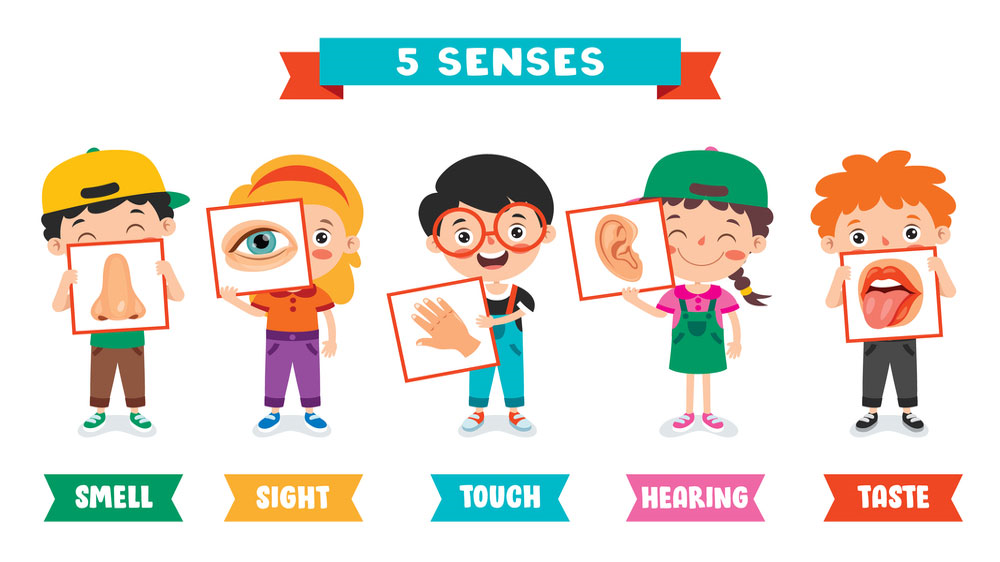افعال حسی verbs of senses، افعالی هستند که حواس پنجگانه (دیدن، شنیدن، بوییدن، لمس کرن و چشیدن) را توصیف میکنند. همچنین افعال حسی (Verbs of Sense یا Sensory Verbs), جزء افعال حالتی هستند.
اطلاعات جامع در مورد جدیدترین روشهای آموزش زبان را اینجا بخوانید.

نویسنده: American-English File
مترجم: رؤیا کریمی جنابی
look/ feel/ smell/ sound/ taste
1. You look tired.
That cake smells good!
These jeans don't feel comfortable.
2. Tim looks like his father. This material feels like silk—is it?
Are you sure this is coffee? It tastes like tea.
3. She looks as if she's been crying. It smells as if something's burning. It sounds as if it's raining.
1. افعال حسی را همراه با صفات به کار برید (look, feel, etc.+ adjective).
2. افعال حسی را همراه با like و اسم به کاربرید (look, feel, etc.+ like+ noun).
3. افعال حسی را با as if و یک عبارت به کار برید (look, feel, etc.+ as if+ clause).
• به جای as if میتوانید از like یا as though استفاده کنید:
It sounds like/ as though it's raining
feel like
feel like میتواند به عنوان فعل هم به کار رود با معنای want/ would like. بعد از آن اسم یا فعل به صورت اسم مصدر (gerund) قرار میگیرد:
I feel like pasta for lunch today (= I'd like pasta for lunch today). I don't feel like going to bed (= I don't want to go to bed)
ترجمه شده از 4 American-English File Student Book
افعال حسی
hear, see, smell, feel, taste
I can hear a noise downstairs.
Can you see the blue circle at the top of the painting?
I can smell something burning. Are you sure you tuned the stove off?
I can feel a draft. Is there a window open?
I can't taste the garlic in the soup.
• پنج فعل اصلی حسی که شامل hear, see, smell, feel, taste میشوند، افعال بیانگر حالت (غیر حرکتی) هستند. معمولاً برای بیان اینکه چیزی در حال حاضر در حال وقوع است از can همراه با این افعال استفاده میکنیم.
• معمولاً افعال حسی به صورت استمراری به کار نمیروند:
NOT I am hearing a noise. I'm feeling a pain behind my eye.
• hear and see به عنوان افعال حرکتی هم به کار میروند و میتوان آنها را به صورت استمراری به کار برد البته در معنایی متفاوت:
I've been hearing good things about you recently. (= I have been receiving information).
I'm seeing James tonight. (= I have arranged to meet him).
see/ hear+ infinitive or gerund
1. I heard the girl play a piece by Chopin.
I saw the man hit his dog.
2. I heard the girl playing a piece by Chopin.
I saw the man hitting his dog.
- اغلب از see/ hear همراه با مفعول و فعل به صورت مصدر یا اسم مصدر(see/ hear+ object+ verb in infinitive of gerund) به کار میرود. معانی آنها کمی متفاوت است:
- See/ hear+ object+ verb in infinitive= you saw or heard the whole action.
- See/ hear+ object+ verb in gerund= you saw/ heard an action in progress of a repeated action.
- چنین تمایزی در مورد افعالی که پس از watch و notice هم قرار میگیرند وجود دارد.
look, feel, smell, sound, taste+ adjective/ noun
1. You look tired. That smells delicious. This music sounds awfu
These shoes feel uncomfortable. The soup tastes a little salty.
2. You look like your mother. It sounds like thunder. This tastes like tea, not coffee.
3. She looked as if/ as though she had been crying.
This smells/ tastes of garlic. This smells/ tastes like garlic.
هنگامی که درباره تأثیری که کسی یا چیزی روی ما دارد صحبت میکنیم، از افعال look, feel, smell, sound and taste استفاده میکنیم.
• پس از این افعال میتوانیم موارد زیر را به کار بریم:
1. یک صفت
2. Like به اضافه یک اسم
3. as if/ as though به اضافه یک عبارت
4. مقایسه smell/ taste of و smell/ taste like:
It tastes/ smells of garlic (= it has the taste/ smell of garlic).
It tastes/ smells like garlic (= it’s taste/ smell is similar to garlic, but it probably isn’t garlic)
seem
1. You seem worried. Is something wrong?
2. You seem to be a little down today. Are you OK?
The waiter seems to have made a mistake with the bill.
3. I seemed like a good idea at the time, but in fact it wasn't.
It seems as if/ as though every time I was the car it rains.
• از seem زمانی استفاده میکنیم که چیزی یا کسی ما را تحت تأثیر قرار میدهد. در اینصورت از طریق ترکیب حواس و آن چه که میدانیم کاری را انجام دهیم و این تنها با یک حس (مثلاً بینایی) صورت نمیگیرد. Seem و look را با هم مقایسه کنید:
You look worried. (= I get this impression from your face).
You seem worried. (= I get this impression from the way you are behaving in general, e.g. voice, actions, etc).
• پس از seem میتوانیم موارد زیر را به کار بریم:
1. یک صفت
2. یک مصدر (ساده یا کامل یا استمراری)
3. like به اضافه اسم یا as if/ as though به اضافه یک عبارت فعلی (verb phrase)
• seem در حالت استمراری به کار نمیرود.
ترجمه شده از 5 American-English File Student Book